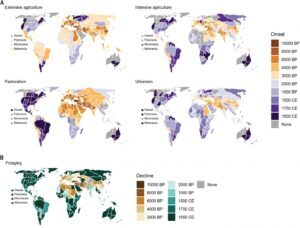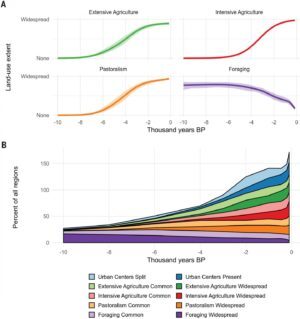
ARIZONA STATE UNIVERSITY—Humans’ dramatic transformation of Earth’s landscape is no recent phenomenon, according to a new study from Science.
The research, which assessed global land use from 10,000 to 170 years ago, reveals that hunter-gatherers, farmers and pastoralists had made significant alterations to the planet by 4,000 years ago, much earlier than indicated by Earth scientists’ previous land-use reconstructions.
“Understanding how humans interact with the environment over the long-term past is one of the best things we can do to help us understand how people will deal with this in the future,” says Michael Barton, co-author and a professor at Arizona State University’s School of Human Evolution and Social Change. “We’re not starting from zero. We’re starting from a long history.”
Researchers can look for evidence of whether ancient peoples’ actions benefited or harmed biodiversity and allowed them to reside sustainably or not in an area for a long amount of time. Studying their environmental successes and failures can give a better idea of how to create positive change as humans continue to reshape the planet.
The study also has implications for the Earth system models used to predict future human environmental impact. Accurate predictions rely on comparing the present to the past — and the data currently representing Earth’s past that is used for those models underestimates human impact.
Suspecting this, the authors set out to gather richer, globalized data from those who know humanity’s past best — archaeologists. They began a crowdsourcing effort, called the ArchaeoGLOBE Project, by sending a massive survey to scholars whose expertise covered areas all over the world. 255 respondents filled out over 700 regional questionnaires, which provided the information for the study.
“Many people have realized for some time now that the study of long-term human-environment interactions must include archaeological knowledge, but our research and dataset really open the door to this sort of collaboration at global scale for the first time,” says Lucas Stephens, lead author of the paper and recent doctoral graduate from the University of Pennsylvania.
“Our aggregate knowledge paints a surprisingly clear, globally coherent picture,” says Nicolas Gauthier, co-author and recent doctoral graduate from Arizona State University.
That picture shows that shifting cultivation and pastoralism had affected over 40% of Earth’s land area by 4,000 years ago. It also reveals that continuous cultivation was common to widespread over most of the planet by 2,000 years ago, over 1,000 years earlier than indicated by today’s most widely referenced land-use study, the History Database of the Global Environment, known as HYDE.
Archaeologists reported on some regions more than others for the ArchaeoGLOBE Project, reflecting the intensity of research in different areas. But by highlighting these gaps, the study helps scientists prioritize their data gathering and provides a starting point for them to continue investigating land use over time.
“Our hope is that it will push the field forward in a way that would not have been possible had everyone worked in isolation,” Gauthier says.
____________________________

A) Onsets represent the earliest time step assessed at the “common” prevalence level (1-20% land area) for extensive agriculture, intensive agriculture, and pastoralism; the earliest time step assessed as “present” for urbanism. B) Decline represents the latest time step assessed at the “common” prevalence level for foraging. Reprinted with permission from: ArchaeoGLOBE Project, SCIENCE, August 30 2019 (DOI: 10.1126/science.aax1192)
____________________________

A) Generalized additive mixed model trends for the extent of each land-use type across all regions, with 95% confidence intervals. B) Cumulative summary of regions per land-use category based on consensus assessments (Common > 1% to 20% regional land area; Widespread > 20% regional land area), with presence or absence of urban centers. Categories are non-exclusive, resulting in plot values >100% of all regions. Reprinted with permission from: ArchaeoGLOBE Project, SCIENCE, August 30 2019 (DOI: 10.1126/science.aax1192)
____________________________
Article Source: Arizona State University news release


